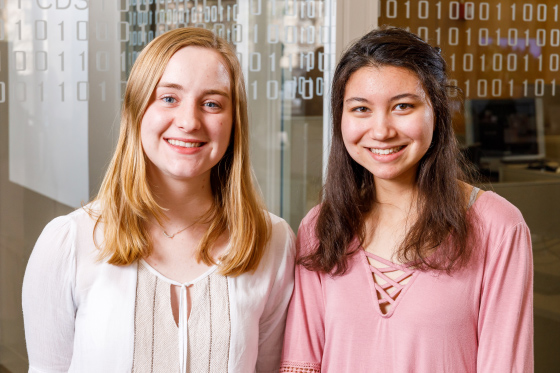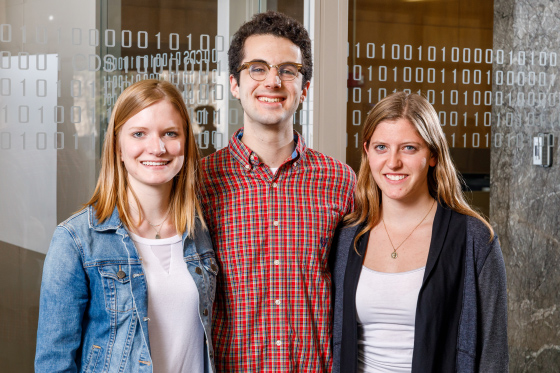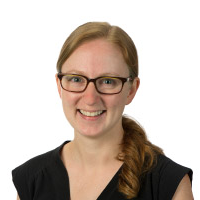2018 Winners
First Place

VoteBuddy
A website and application that gives voters information on local, state, and national elections.
Audrey Kurz, First Year of Studies, Liberal Studies, College of Arts and Letters
Kelly Moran, First Year of Studies, Mechanical Engineering, College of Engineering
Runner-Up

CrowdView
A website that indicates which campus buildings are most crowded by using heat maps that update every five minutes.
Catherine Markley, Computer Science, College of Engineering
Chris Foley, Computer Science, College of Engineering
Bridget Sabbagh, Computer Science, College of Engineering
2018 Judges

Lauren Ajamie
Electronic Resources Librarian
Hesburgh Libraries
Lauren Ajamie is the Electronic Resources and Systems Librarian in the Hesburgh Libraries' Information Technology Program. She provides support for library software that allows search and delivery of scholarly resources and serves as product owner for the Hesburgh Libraries website.

Ramzi Bualuan
Associate Professional Specialist and
Director of Undergraduate Studies
Department of Computer Science and Engineering
Ramzi Bualuan teaches courses in Databases, Advanced Database Projects, and Visual FX. He is also the Director of Undergraduate Studies for the CSE department, and directs the College's Introduction to Engineering Program (IEP), a summer camp for high school students interested in engineering.

Mike Chapple
Associate Teaching Professor of IT, Analytics, and Operations,
Mendoza
College of Business
Mike Chapple is academic director of Notre Dame’s Master of Science in Business Analytics program and associate teaching professor of IT, Analytics, and Operations where he teaches undergraduate and graduate courses in business analytics and cybersecurity.

Annie Sauer
Tech Training & Change Management Professional,
Office of Information Technologies
Annie Sauer is a technical trainer and change manager for OIT who works primarily with Google and Microsoft products. She helps users understand technology changes, provides training and documentation for new initiatives, and facilitates the successful implementation of new products and services.
This guide lists the categories for judging the projects that will be presented at the conclusion of the hackathon. Each category has a weighted percentage that will be used to calculate the final score for each team. This explanatory material should be used as a guide for scoring each area.
Impact 20%
The solution should have a significant impact on either library operations or the services that students and faculty use on a regular basis. An indication of impact would be represented in factors such as ease of use for a particular library service, increasing accessibility, increasing availability, fostering communication, etc. The product should advance the library’s ultimate goal of “connecting people to knowledge”.
Teamwork 20%
This category emphasizes the way in which the team members cooperate in order to create their product. The team should involve every member in the creative process and try to take advantage of individual strengths. This should be evident in the team presentation, and the participation of each team member should be clearly evident. Teams that incorporate a diverse set of skills and styles but who work in a unified manner have an advantage in this category.
Innovation 30%
Simply put, innovation represents a degree of “pushing the envelope” for access to services and content. The key criterion for the category is advancement of library services into areas that have not been previously explored. Another area of of focus is advancement using cutting edge methods for activities such as user interaction, data manipulation and presentation, and use of new information technology techniques.
Usability 15%
This category represents the ease of use for library patrons when they engage with the target content or service. The user interface should be intuitive and uncomplicated. The goals of the product should be clear. The information presented by the application or product should be clear, and the method for interaction with the content or service should be understandable by everyone.
Presentation 15%
The final presentation of the product to the judge should be professional, clear, and meaningful. Aspects that could add to the quality of the presentation could be creativity, engagement with the audience, style of the presentation, or simplicity. Does the presentation clearly communicate the intent of the product? Is the presentation well structured so that the judge and audience can understand the nature of the problem, the implementation of the solution, and a conclusion that states what the next steps are?
Hesburgh Libraries Hackathon Code of Conduct
Social Practices
In keeping with the codes of conduct set forth in du Lac: A Guide to Student Life, our Hackathon is dedicated to providing a harassment-free experience for everyone, regardless of gender, gender identity and expression, age, sexual orientation, disability, physical appearance, race, ethnicity, nationality, religion, previous hackathon attendance or computing experience. We do not tolerate harassment of hackathon participants in any form.
In order to foster a positive and professional learning environment we encourage the following kinds of behaviors:
- Use welcoming and inclusive language
- Be respectful of different viewpoints and experiences
- Gracefully accept constructive criticism
- Focus on what is best for all of us in the community
- Show courtesy and respect towards other community members
Photography
All participants understand that the Hesburgh Libraries Hackathon may be photographed, videotaped, and or recorded by the Hesburgh Libraries, and grant the Hesburgh Libraries the right to use or refrain from using their name and/or likeness without their approval or compensation. Photography by participants is encouraged, but other participants must be given a reasonable chance to opt-out from being photographed. If they object to the taking of their photograph, comply with their request. It is inappropriate to take photographs in contexts where people have a reasonable expectation of privacy.
Inappropriate Behavior
If you witness or experience any transgressions of this Code of Conduct at the Hackathon, please tell a member of the Hackathon staff immediately, or email hesburgh-library-hackathon-list@nd.edu.